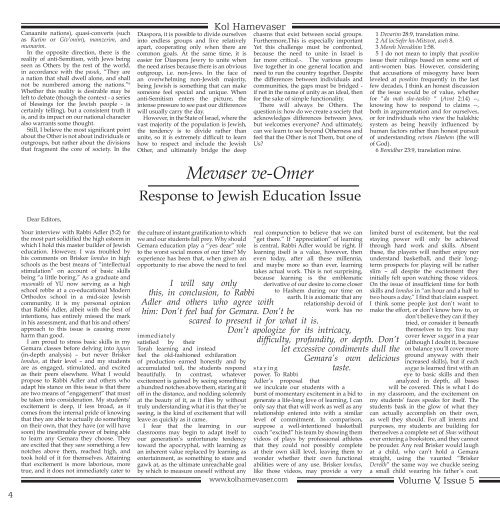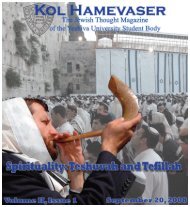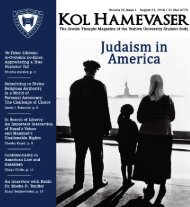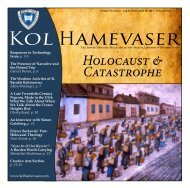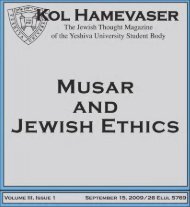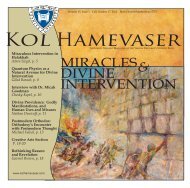The Other in Judaism - Kol Hamevaser
The Other in Judaism - Kol Hamevaser
The Other in Judaism - Kol Hamevaser
Create successful ePaper yourself
Turn your PDF publications into a flip-book with our unique Google optimized e-Paper software.
Canaanite nations), quasi-converts (such<br />
as Kutim or Giv’onim), mamzerim, and<br />
mumarim.<br />
In the opposite direction, there is the<br />
reality of anti-Semitism, with Jews be<strong>in</strong>g<br />
seen as <strong>Other</strong>s by the rest of the world,<br />
<strong>in</strong> accordance with the pasuk, “<strong>The</strong>y are<br />
a nation that shall dwell alone, and shall<br />
not be numbered among the nations.” 6<br />
Whether this reality is desirable may be<br />
left to debate (though the context - a series<br />
of bless<strong>in</strong>gs for the Jewish people - is<br />
certa<strong>in</strong>ly tell<strong>in</strong>g), but a consistent truth it<br />
is, and its impact on our national character<br />
also warrants some thought.<br />
Still, I believe the most significant po<strong>in</strong>t<br />
about the <strong>Other</strong> is not about <strong>in</strong>dividuals or<br />
outgroups, but rather about the divisions<br />
that fragment the core of society. In the<br />
Diaspora, it is possible to divide ourselves<br />
<strong>in</strong>to endless groups and live relatively<br />
apart, cooperat<strong>in</strong>g only when there are<br />
common goals. At the same time, it is<br />
easier for Diaspora Jewry to unite when<br />
the need arises because there is an obvious<br />
outgroup, i.e. non-Jews. In the face of<br />
an overwhelm<strong>in</strong>g non-Jewish majority,<br />
be<strong>in</strong>g Jewish is someth<strong>in</strong>g that can make<br />
someone feel special and unique. When<br />
anti-Semitism enters the picture, the<br />
<strong>in</strong>tense pressure to see past our differences<br />
will usually carry the day.<br />
However, <strong>in</strong> the State of Israel, where the<br />
vast majority of the population is Jewish,<br />
the tendency is to divide rather than<br />
unite, so it is extremely difficult to learn<br />
how to respect and <strong>in</strong>clude the Jewish<br />
<strong>Other</strong>, and ultimately bridge the deep<br />
<strong>Kol</strong> <strong>Hamevaser</strong><br />
chasms that exist between social groups.<br />
Furthermore,This is especially important<br />
Yet this challenge must be confronted,<br />
because the need to unite <strong>in</strong> Israel is<br />
far more critical.-. <strong>The</strong> various groups<br />
live together <strong>in</strong> one general location and<br />
need to run the country together. Despite<br />
the differences between <strong>in</strong>dividuals and<br />
communities, the gaps must be bridged -<br />
if not <strong>in</strong> the name of unity as an ideal, then<br />
for the sake of simple functionality.<br />
<strong>The</strong>re will always be <strong>Other</strong>s. <strong>The</strong><br />
question is: how do we create a society that<br />
acknowledges differences between Jews,<br />
but welcomes everyone And ultimately,<br />
can we learn to see beyond <strong>Other</strong>ness and<br />
feel that the <strong>Other</strong> is not <strong>The</strong>m, but one of<br />
Us<br />
Mevaser ve-Omer<br />
Response to Jewish Education Issue<br />
1 Devarim 28:9, translation m<strong>in</strong>e.<br />
2 Ad locSefer ha-Mitsvot, aseh 8.<br />
3 Moreh Nevukhim 1:58.<br />
5 I do not mean to imply that posekim<br />
issue their rul<strong>in</strong>gs based on some sort of<br />
anti-women bias. However, consider<strong>in</strong>g<br />
that accusations of misogyny have been<br />
leveled at posekim frequently <strong>in</strong> the last<br />
few decades, I th<strong>in</strong>k an honest discussion<br />
of the issue would be of value, whether<br />
for “da mah she-tashiv “ (Avot 2:14) --,<br />
know<strong>in</strong>g how to respond to claims --,<br />
both <strong>in</strong> argumentation and for ourselves,<br />
or for <strong>in</strong>dividuals who view the halakhic<br />
system as be<strong>in</strong>g heavily <strong>in</strong>fluenced by<br />
human factors rather than honest pursuit<br />
of understand<strong>in</strong>g retson Hashem (the will<br />
of God).<br />
6 Bemidbar 23:9, translation m<strong>in</strong>e.<br />
Dear Editors,<br />
4<br />
Your <strong>in</strong>terview with Rabbi Adler (5:2) for<br />
the most part solidified the high esteem <strong>in</strong><br />
which I hold this master builder of Jewish<br />
education. However, I was troubled by<br />
his comments on Brisker lomdus <strong>in</strong> high<br />
schools as the best means of “<strong>in</strong>tellectual<br />
stimulation” on account of basic skills<br />
be<strong>in</strong>g “a little bor<strong>in</strong>g.” As a graduate and<br />
musmakh of YU now serv<strong>in</strong>g as a high<br />
school rebbe at a co-educational Modern<br />
Orthodox school <strong>in</strong> a mid-size Jewish<br />
community, it is my personal op<strong>in</strong>ion<br />
that Rabbi Adler, albeit with the best of<br />
<strong>in</strong>tentions, has entirely missed the mark<br />
<strong>in</strong> his assessment, and that his and others’<br />
approach to this issue is caus<strong>in</strong>g more<br />
harm than good.<br />
I am proud to stress basic skills <strong>in</strong> my<br />
Gemara classes before delv<strong>in</strong>g <strong>in</strong>to iyyun<br />
(<strong>in</strong>-depth analysis) – but never Brisker<br />
lomdus, at their level – and my students<br />
are as engaged, stimulated, and excited<br />
as their peers elsewhere. What I would<br />
propose to Rabbi Adler and others who<br />
adapt his stance on this issue is that there<br />
are two means of “engagement” that must<br />
be taken <strong>in</strong>to consideration. My students’<br />
excitement is deep, if less broad, as it<br />
comes from the <strong>in</strong>ternal pride of know<strong>in</strong>g<br />
that they are able to actually do someth<strong>in</strong>g<br />
on their own, that they have (or will have<br />
soon) the <strong>in</strong>estimable power of be<strong>in</strong>g able<br />
to learn any Gemara they choose. <strong>The</strong>y<br />
are excited that they saw someth<strong>in</strong>g a few<br />
notches above them, reached high, and<br />
took hold of it for themselves. Atta<strong>in</strong><strong>in</strong>g<br />
that excitement is more laborious, more<br />
true, and it does not immediately cater to<br />
the culture of <strong>in</strong>stant gratification to which<br />
we and our students fall prey. Why should<br />
Gemara education play a “yes dear” role<br />
to the worst social mores of our time My<br />
experience has been that, when given an<br />
opportunity to rise above the need to feel<br />
immediately<br />
satisfied by their<br />
Torah learn<strong>in</strong>g and <strong>in</strong>stead<br />
feel the old-fashioned exhilaration<br />
of production earned honestly and by<br />
accumulated toil, the students respond<br />
beautifully. In contrast, whatever<br />
excitement is ga<strong>in</strong>ed by see<strong>in</strong>g someth<strong>in</strong>g<br />
a hundred notches above them, star<strong>in</strong>g at it<br />
off <strong>in</strong> the distance, and nodd<strong>in</strong>g solemnly<br />
at the beauty of it, as it flies by without<br />
truly understand<strong>in</strong>g what it is that they’re<br />
see<strong>in</strong>g, is the k<strong>in</strong>d of excitement that will<br />
leave as quickly as it came.<br />
I fear that the learn<strong>in</strong>g <strong>in</strong> our<br />
classrooms may beg<strong>in</strong> to adapt itself to<br />
our generation’s unfortunate tendency<br />
toward the apocryphal, with learn<strong>in</strong>g as<br />
an <strong>in</strong>herent value replaced by learn<strong>in</strong>g as<br />
enterta<strong>in</strong>ment, as someth<strong>in</strong>g to stare and<br />
gawk at, as the ultimate unreachable goal<br />
by which to measure oneself without any<br />
www.kolhamevaser.com<br />
real compunction to believe that we can<br />
“get there.” If “appreciation” of learn<strong>in</strong>g<br />
is central, Rabbi Adler would be right. If<br />
learn<strong>in</strong>g itself is a value, however, then<br />
even today, after all these millennia,<br />
and maybe more so than ever, learn<strong>in</strong>g<br />
takes actual work. This is not surpris<strong>in</strong>g,<br />
because learn<strong>in</strong>g is the emblematic<br />
derivative of our desire to come closer<br />
I will say only<br />
this, <strong>in</strong> conclusion, to Rabbi<br />
Adler and others who agree with<br />
him: Don’t feel bad for Gemara. Don’t be<br />
scared to present it for what it is.<br />
to Hashem dur<strong>in</strong>g our time on<br />
earth. It is axiomatic that any<br />
relationship devoid of<br />
work has no<br />
Don’t apologize for its <strong>in</strong>tricacy,<br />
difficulty, profundity, or depth. Don’t<br />
let excessive condiments dull the<br />
Gemara’s own delicious<br />
taste.<br />
stay<strong>in</strong>g<br />
power. To Rabbi<br />
Adler’s proposal that<br />
we <strong>in</strong>culcate our students with a<br />
burst of momentary excitement <strong>in</strong> a bid to<br />
generate a life-long love of learn<strong>in</strong>g, I can<br />
only say that that will work as well as any<br />
relationship entered <strong>in</strong>to with a similar<br />
level of commitment. In comparison,<br />
suppose a well-<strong>in</strong>tentioned basketball<br />
coach “excited” his team by show<strong>in</strong>g them<br />
videos of plays by professional athletes<br />
that they could not possibly complete<br />
at their own skill level, leav<strong>in</strong>g them to<br />
wonder whether their own functional<br />
abilities were of any use. Brisker lomdus,<br />
like those videos, may provide a very<br />
limited burst of excitement, but the real<br />
stay<strong>in</strong>g power will only be achieved<br />
through hard work and skills. Absent<br />
these, the players will neither enjoy nor<br />
understand basketball, and their longterm<br />
prospects for play<strong>in</strong>g will be rather<br />
slim – all despite the excitement they<br />
<strong>in</strong>itially felt upon watch<strong>in</strong>g those videos.<br />
On the issue of <strong>in</strong>sufficient time for both<br />
skills and lomdus <strong>in</strong> “an hour and a half to<br />
two hours a day,” I f<strong>in</strong>d that claim suspect.<br />
I th<strong>in</strong>k some people just don’t want to<br />
make the effort, or don’t know how to, or<br />
don’t believe they can if they<br />
tried, or consider it beneath<br />
themselves to try. You may<br />
cover fewer sugyot <strong>in</strong> a year<br />
(although I doubt it, because<br />
on balance you’ll cover more<br />
ground anyway with their<br />
<strong>in</strong>creased skills), but if each<br />
sugya is learned first with an<br />
eye to basic skills and then<br />
analyzed <strong>in</strong> depth, all bases<br />
will be covered. This is what I do<br />
<strong>in</strong> my classroom, and the excitement on<br />
my students’ faces speaks for itself. <strong>The</strong><br />
students bask <strong>in</strong> the glow of what they<br />
can actually accomplish on their own,<br />
as well they should. For all <strong>in</strong>tents and<br />
purposes, my students are build<strong>in</strong>g for<br />
themselves a complete set of Shas without<br />
ever enter<strong>in</strong>g a bookstore, and they cannot<br />
be prouder. Any real Brisker would laugh<br />
at a child, who can’t hold a Gemara<br />
straight, us<strong>in</strong>g the vaunted “Brisker<br />
Derekh” the same way we chuckle see<strong>in</strong>g<br />
a small child wear<strong>in</strong>g his father’s coat.<br />
Volume V, Issue 5


